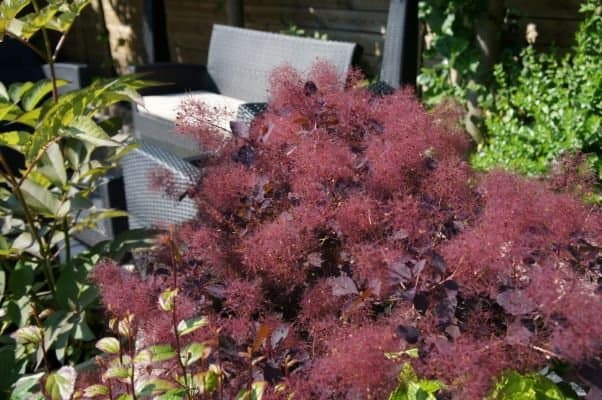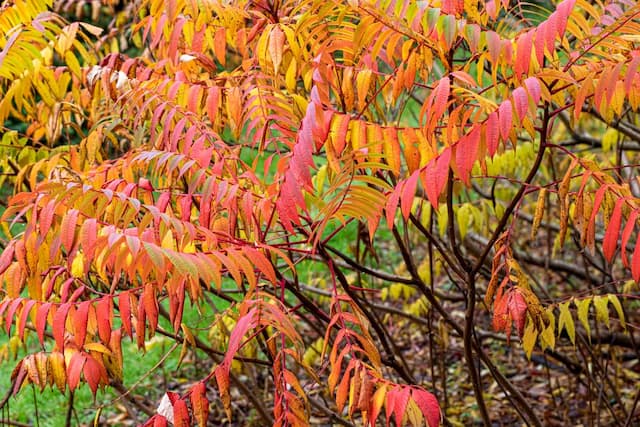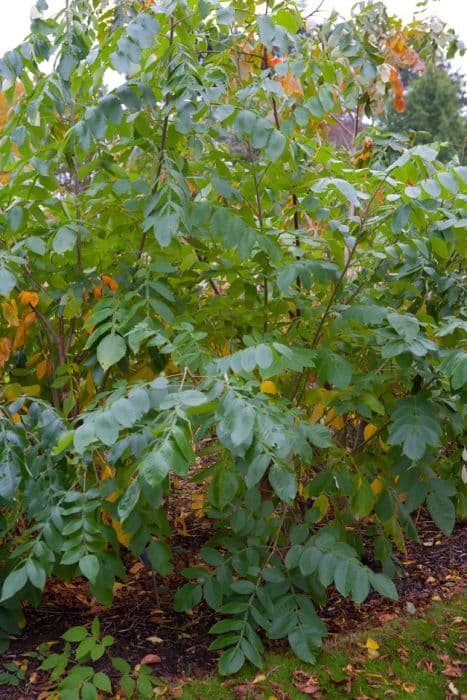Smoke bush Cotinus coggygria 'Royal Purple'











ABOUT
The plant commonly known as Royal Purple Smoke Tree features an eye-catching array of colors and textures that make it an ornamental favorite in many gardens. Its foliage presents a striking deep purple, almost burgundy hue, which maintains its vibrancy throughout the spring and summer months. As autumn approaches, the leaves transition to a stunning reddish-purple, adding warmth to the seasonal landscape. The signature look of the Royal Purple Smoke Tree comes from its billowy flowers that resemble puffs of smoke. These flowers are a light, pinkish-purple, and they stand in striking contrast to the dark foliage, creating a soft, ethereal effect that seems to hover around the plant. Additionally, the leaves are round, slightly velvety to the touch and can appear almost black under certain lighting conditions, providing a dramatic backdrop for the ’smoke‘ which is actually composed of large clusters of tiny, airy flowers. This smoke tree variety is also appreciated for the unique texture it brings to gardens with its smooth, dark bark and its branches that spread outwards, making it a visually interesting specimen throughout the year. The dramatic appeal of the Royal Purple Smoke Tree is undeniable, and it continues to be a popular choice for gardeners looking to add a touch of regal elegance to their outdoor spaces.
About this plant
 Names
NamesFamily
Anacardiaceae.
Synonyms
Royal Purple Smoke Tree, Royal Purple Smokebush, Royal Purple Smoketree, Venetian Sumac, Purple Smoke Tree, Purple Smoke Bush.
Common names
Cotinus coggygria var. purpureus, Rhus cotinus 'Royal Purple', Cotinus coggygria f. purpureus, Cotinus coggygria 'Purpureus'.
 Toxicity
ToxicityTo humans
Smoke bush is not known to be toxic to humans. Therefore, ingestion of any part of the Smoke bush typically does not result in poisoning or produce harmful symptoms. However, it is generally advised to avoid eating ornamental plants as they are not intended for consumption and some individuals may experience an allergic reaction or gastrointestinal discomfort if plant material is ingested.
To pets
Smoke bush is also not known to be toxic to pets. It is not commonly associated with poisoning in animals and should not produce harmful symptoms if ingested by pets. Nonetheless, as with humans, ingestion of ornamental plants like the Smoke bush is not recommended and may sometimes lead to mild gastrointestinal upset in some animals. Always monitor pets around plants and consult with a veterinarian if you suspect your pet is ill after consuming any plant material.
 Characteristics
CharacteristicsLife cycle
Perennials
Foliage type
Deciduous
Color of leaves
Purple
Flower color
Pink
Height
10-15 feet [3-4.5 meters]
Spread
10-15 feet [3-4.5 meters]
Plant type
Shrub
Hardiness zones
5-8
Native area
Southern Europe, Central China
Benefits
 General Benefits
General Benefits- Ornamental Value: Adds striking purple foliage and smoky pink flowers to landscapes, enhancing aesthetic appeal.
- Drought Tolerance: Once established, it requires minimal watering, making it suitable for xeriscaping and reducing maintenance needs.
- Seasonal Interest: Provides year-round interest with foliage color changes in fall and unique seed puffs in winter.
- Wildlife Attraction: Attracts pollinators like bees and butterflies, supporting local ecosystems.
- Low Maintenance: Generally resistant to pests and diseases, requiring less intervention and care.
- Shade Tolerance: Capable of growing in partial shade, offering flexibility in garden design and planting locations.
- Hardiness: Adapts well to a range of climates and can withstand cold temperatures once established.
- Soil Adaptability: Tolerates a variety of soil types, including less fertile soils, reducing the need for soil amendments.
 Medical Properties
Medical PropertiesThis plant is not used for medical purposes.
 Air-purifying Qualities
Air-purifying QualitiesThis plant is not specifically known for air purifying qualities.
 Other Uses
Other Uses- The smoke bush's leaves can be used to create a natural dye for fabrics, providing a range of colors such as yellow, green, or brown depending upon the mordant used.
- Woodworkers may value smoke bush wood for its decorative grain, which can be used for crafting small wooden objects like handles, knobs, or inlays.
- The dense foliage of the smoke bush can provide a natural screen, offering privacy in gardens or around patios.
- Smoke bush branches can be used in floral arrangements, particularly when the foliage turns its distinctive purple color in the fall.
- The plant's seed clusters can make unique additions to dried flower arrangements or as textural elements in craft projects.
- Landscape artists can use the striking purple foliage of the smoke bush to create contrasts in garden designs or as a backdrop for showcasing other plants.
- The fibers from the bark can be used for making a rough twine or cord for garden use or craft activities.
- The dramatic appearance of smoke bush foliage in autumn can be captured through photography and used in design and artwork.
- During winter, the bare structure of smoke bush provides sculptural interest in the landscape, which can be an inspiration for gardenists or landscape painters.
- Smoke bush can be used as a natural food coloring in culinary applications, where permitted and known to be safe, for a unique visual appeal.
Interesting Facts
 Feng Shui
Feng ShuiThe Smoke Bush is not used in Feng Shui practice.
 Zodiac Sign Compitability
Zodiac Sign CompitabilityThe Smoke Bush is not used in astrology practice.
 Plant Symbolism
Plant Symbolism- Beauty and Uniqueness: Also known as 'Smoke Bush', its distinctive purple foliage and smoky flower clusters present a sense of uniqueness and stand out beauty in the landscape.
- Mystery: The smoky appearance of its billowy flowers can symbolize the enigmatic and mysterious aspects of nature.
- Transformation: 'Smoke Bush' is deciduous, and its leaves change colors throughout the seasons, symbolizing change and transformation.
- Illusion: The smoke-like flowers create a visual effect of a mist or smoke, symbolizing illusion or things not being quite as they appear.
 Water
WaterThe Smoke Tree requires moderate watering, with the soil being allowed to dry out between waterings. During its active growth in spring and summer, water the plant deeply about once a week with approximately two gallons, depending on the size of the tree and weather conditions. Reduce watering in the fall as the plant goes dormant, and during the winter, you might only need to water it every two to three weeks, especially if there's rainfall. Always check the top inch of the soil for dryness before watering again. Overwatering can lead to root rot, so ensure good drainage and do not let the plant sit in waterlogged soil.
 Light
LightSmoke Trees thrive in full sunlight to achieve the best foliage color and flower production. Planting the Smoke Tree in a spot where it receives at least six hours of direct sunlight a day is ideal. However, the tree can tolerate partial shade, but too little light may result in less vibrant leaf coloration and fewer blooms.
 Temperature
TemperatureSmoke Trees are hardy and adaptable to a wide range of temperature conditions. They prefer temperatures ranging from 60 to 75 degrees Fahrenheit during the growing season. They can survive winter temperatures down to -20 degrees Fahrenheit but are best suited to climates where the temperature does not substantially exceed 95 degrees Fahrenheit in the summer.
 Pruning
PruningPrune the Smoke Tree to maintain its shape and to remove any dead or damaged branches. Pruning should be done in late winter or early spring before new growth starts, typically once a year. You can also cut back the plant more drastically every few years to encourage more vigorous growth and better foliage color if desired.
 Cleaning
CleaningAs needed
 Soil
SoilThe Smoke Tree, also known as Royal Purple Smoke Bush, thrives in well-draining soil with a pH between 5.5 and 7.5. A mix containing loam, compost, and a small amount of gritty sand or perlite is ideal for ensuring proper drainage and fertility.
 Repotting
RepottingThe Smoke Tree typically doesn't require frequent repotting as it is most often planted in the ground. If grown in containers, repot every 2-3 years to refresh the soil and accommodate root growth.
 Humidity & Misting
Humidity & MistingThe Smoke Tree is not particularly humidity-sensitive and does well in average outdoor humidity levels. It is quite adaptable to different humidity conditions in the environment where it is planted.
 Suitable locations
Suitable locationsIndoor
Provide bright light, well-draining soil, and room for growth.
Outdoor
Plant in full sun, well-draining soil, and prune in late winter.
Hardiness zone
5-8 USDA
 Life cycle
Life cycleThe life of the smoke bush ‘Royal Purple’ (Cotinus coggygria 'Royal Purple') begins with seed germination, which occurs in warm, moist soil conditions, typically in spring. After germination, the seedling grows rapidly and develops into a juvenile plant with distinctive purple leaves. During its growth phase, the smoke bush enters a period of vegetative growth where it develops its branching structure and increases in size. As the plant matures, it enters the flowering stage usually in late spring to early summer, producing feathery, smoke-like flower clusters that give the plant its common name. After pollination, the plant produces small fruit or seeds which when mature, are dispersed by wind or other means, completing the reproductive cycle. In late autumn, the plant enters dormancy, shedding its leaves, and prepares to survive through winter conditions until the cycle begins anew with the next growing season.
 Propogation
PropogationPropogation time
Early Spring
Propogation: The Cotinus coggygria 'Royal Purple', commonly known as the Royal Purple Smoke Bush, is typically propagated by softwood cuttings. The best time to propagate is in late spring to early summer when the plant's new growth is mature enough yet still soft. To propagate, a cutting of about 4 to 6 inches (10 to 15 cm) long is taken, with the lower leaves removed, and the cut end dipped in rooting hormone to increase the chances of success. The cutting should then be planted in a well-draining soil mixture and kept moist until roots develop. Providing bottom heat can improve the success rate of rooting. Once the roots are established, the new Royal Purple Smoke Bush can be transplanted to its final location.




